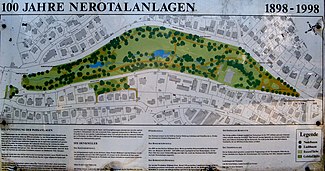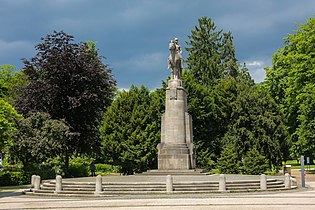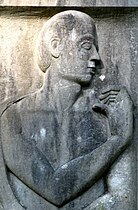
Wiesbaden is the capital of the German state of Hesse, and the second-largest Hessian city after Frankfurt am Main. With around 283,000 inhabitants, it is Germany's 24th-largest city. Wiesbaden forms a conurbation with a population of around 500,000 with the neighbouring city of Mainz. This conurbation is in turn embedded in the Rhine-Main Metropolitan Region—Germany's second-largest metropolitan region after Rhine-Ruhr—which also includes the nearby cities of Frankfurt am Main, Darmstadt, Offenbach am Main, and Hanau, and has a combined population exceeding 5.8 million.

Bad Schwalbach is the district seat of Rheingau-Taunus-Kreis, in Hesse, Germany.
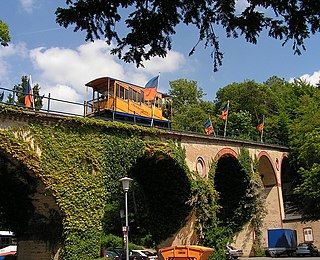
The Nerobergbahn is a funicular railway in Wiesbaden, Germany. The line links the city, with a station at the north of the Nerotalanlagen, with the Neroberg hill to its north, which offers a panorama view.
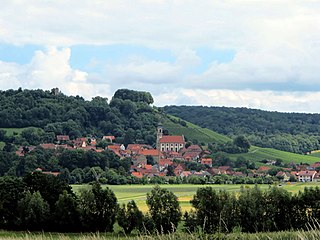
Castell is a municipality in the district of Kitzingen in Bavaria in Germany. It was the seat of the Counts of Castell. Today it is part of the municipal association Wiesentheid. It has around 800 inhabitants.
The Wiesbaden Bismarck Tower was one of approximately 240 monuments built in honour of Otto von Bismarck between 1869 and 1934. Wiesbaden's Bismarck Tower was the tallest Bismarck memorial with a height of 50 metres (160 ft). The wooden tower was built in 1910 close to the former watch tower on the Height of Bierstadt. It was planned only as interim solution to be later replaced by a solid structure with a lift. However, this project did not materialise due to lack of funding. In 1916 the tower, nicknamed the "Eiffel Tower of Wiesbaden", was closed to visitors and used as military observation post. In 1918 it was demolished due to its poor state of repair.

Jelenia Góra Valley in Poland is a big valley at the Silesian northern side of the Western Sudetes and next to Kłodzko Valley the largest intermontane basin of the Sudetes. It is situated at an altitude of 250–400 meters above sea level and covers an area of 273 km2. In the 19th century, the lovely landscape attracted the Prussian high nobility, which built magnificent palaces, manors and parks. The enormous number of stately homes turned the valley into one of the most important garden landscapes in Middle Europe.

Ingeborg Bronsart von Schellendorf was a Finnish-German composer.
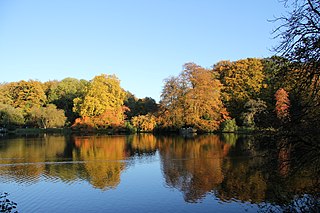
Botanischer Garten Rombergpark, or informally Rombergpark, is an extensive municipal botanical garden and arboretum in Dortmund, North Rhine-Westphalia, Germany. With its total area of 68 hectares the Rombergpark is one of the largest botanical gardens in the world. It is always freely open.
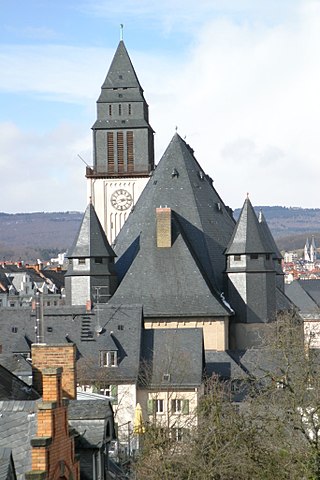
The Lutherkirche is one of four main Protestant churches in Wiesbaden, the capital of Hesse, Germany. It was built between 1908 and 1910 in Jugendstil and in accordance with the Wiesbadener Programm, to a design by Friedrich Pützer. With two organs and good acoustics, it is also a concert venue.

A large number of monuments were erected in Germany in honour of Emperor William I. As early as 1867 the Berlin sculptor, Friedrich Drake, had created the first equestrian statue, that portrayed William I as the King of Prussia. To date the Prussian Monument Institute has recorded:
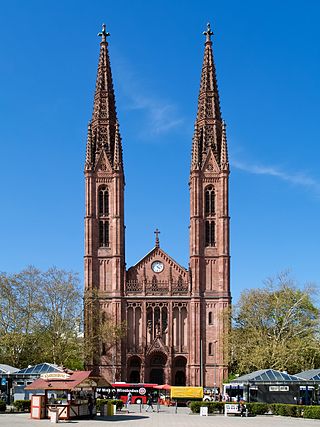
St. Bonifatius in Wiesbaden, Germany, is the central Catholic parish and church in the capital of Hesse. The present building was designed by architect Philipp Hoffmann in Gothic Revival style and built from 1844 to 1849. Its twin steeples of 68 m (223 ft.) dominate the Luisenplatz. The parish is part of the Diocese of Limburg.
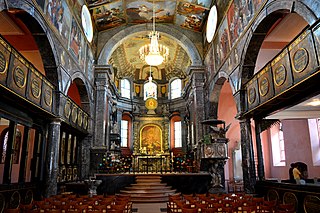
The Unionskirche is the active Protestant parish church of Idstein, a town in the Rheingau-Taunus district in the German state of Hesse. Idstein was a residence of the counts of Nassau. The church building in the center of the historic Altstadt dates back to the 14th century when it was built as a collegiate church. It became Lutheran during the Reformation. Its interior was adapted in the 17th century to become a Lutheran Predigt- und Hofkirche. The most prominent decoration in the church is the series of 38 paintings by the Flemish painter Michael Angelo Immenraedt, an exponent of Flemish Baroque painting, and others. They follow a program of biblical scenes.

The Kurhaus is the spa house in Wiesbaden, the capital of Hesse, Germany. It serves as the city's convention centre, and the social center of the spa town. In addition to a large and a smaller hall, it houses a restaurant and the Wiesbaden Casino, or Spielbank, which is notable for allowing the "highest roulette stakes in Germany", and where Fyodor Dostoyevsky was said to have received the inspiration for his novel The Gambler.

The Ringkirche is a Protestant church in Wiesbaden, the state capital of Hesse, Germany. The Romanesque Revival church was built between 1892 and 1894 and designed by Johannes Otzen. The historic monument also serves as a concert venue.
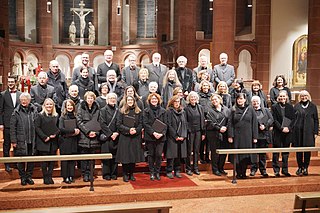
The Chor von St. Bonifatius is a German mixed choir, the church choir of the parish St. Bonifatius, Wiesbaden. It was founded in 1862 as a male choir and was a mixed choir from 1887. From 1981 to 2018, it was conducted by Gabriel Dessauer, who founded two children's choirs. The group sang the first performance in Germany of John Rutter's Mass of the Children and performed in Azkoitia, San Sebastián, Görlitz, Bruges, Macon and Rome. Colin Mawby composed for the choir the Missa solemnis Bonifatius-Messe for the 150th anniversary, celebrated on 3 October 2012. From 2019, the choir has been conducted by Roman Twardy who conducted in his first concert Dvořák's Stabat Mater. On 1 January 2022, Johannes Schröder became church musician. He conducted as his first choral concert Verdi's Requiem in an arrangement for small ensemble.

Joseph Johann Ludwig Uphues was a German sculptor.

Kaspar Kögler was a German painter, illustrator and writer.
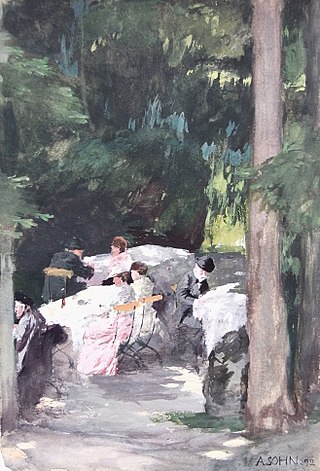
The Malkastenpark is a historic private park, now in the centre of Düsseldorf, North Rhine-Westphalia, Germany. The name refers to a group of artists, Malkasten, founded in 1848. The park is also known as the Jacobigarten, after the original owners who created a Baroque garden. It is now a public garden with both Baroque features and English landscape garden elements, and a listed historic monument.
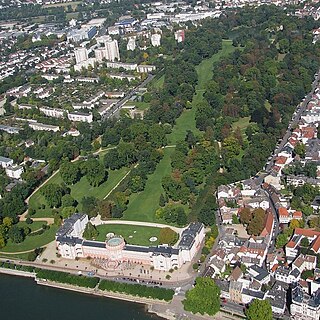
The Schlosspark Biebrich is a park at Schloss Biebrich in Wiesbaden-Biebrich, Hesse, Germany. First designed as a French formal garden, it was expanded changed to an English landscape garden and expanded 1817 to 1823, the last project of Friedrich Ludwig von Sckell. The public park extends north of the building in the valley of the Mosbach creek for around 1,200 m and is 250 m wide. It is the venue for the annual horse show Internationales Pfingstturnier Wiesbaden.
Friedrich August Ludwig, Graf von Bismarck was a German lawyer and Member of Parliament.
